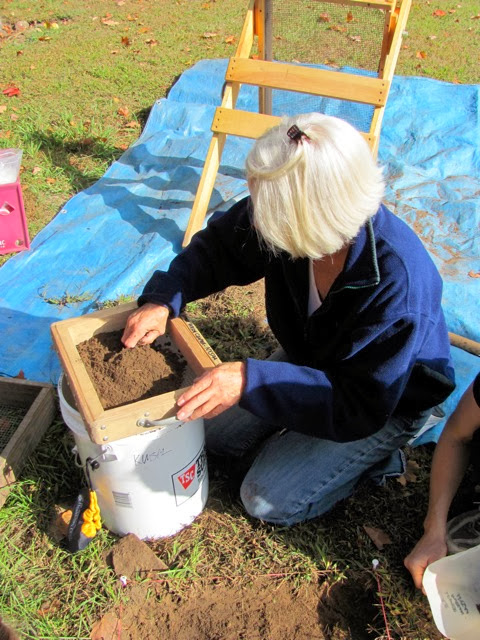I put this picture first because I thought it was a really cool photo (props to Laurie). Pat and I, working on STP 1, listen to Carol as she tells us what's what with soil types. We had just encountered our first traces of light-colored alluvial soil and wanted to know what it meant.
When I excavated at a site in Upstate New York, the sight of the yellowish subsoil meant that we had reached a sterile layer. We would continue to dig until no more brown organic soil was left, but there was nothing to find in the subsoil except fossils (which are cool, but not what we were looking for). In this case, given that the site was once beside a body of water, it's possible that there are more organic layers beneath the alluvium. Alternating organic and alluvial layers reflect the sequence of floods throughout prehistory.
On Day 3 we continued excavating STPs 1 and 2 and began STP 3, which has turned out to be the most exciting STP yet (probably not coincidentally, it is also the closest to the nineteenth-century St. Mark's Church, which no longer stands). You can see the team working on STP 3 in the photo below. See how rapt they are? That is what the prospect of NAILS will do to you. (Old nails are the best, especially when they're long and corroded. One nail found in STP 3 had a piece of brick stuck to it through corrosion.)
STP 3 contained not only nails but many other artifacts - including pieces of glass and brick - some which were found while digging, and others which were discovered while screening the dirt through a screen, as shown below.
Below you can see Carol looking for artifacts in the shaker screen (we now have two). The most interesting of our irrelevant (for our purposes) finds was a modern bullet. Also irrelevant: fifty million rocks. There were also some rocks that were not irrelevant, but I'll get to those in a minute.
Here are some relevant finds: a piece of glass and a nail ...
...
After they're discovered, dusted off, and (if it's the Sutton Hoo helmet, a nail, or something similarly momentous) shown to everyone at the dig, the finds go into specially labeled bags. We use small plastic bags to hold small and delicate finds (as shown below, to the right of the trench). These small bags get put in a bigger bag containing material from the entire level. Artifacts are important, but without context they lose much of their significance.
Context, in the case of a nail, would be the STP in which it was found, the level of that STP in which it was found, the coordinates of the southwest corner of the STP, the name of the site, and the location of the site (town, state). All of these details are part of the process of recording. I can't tell you how may times I've read this anecdote in some archaeological textbook:
"When [Famous Archaeologist] died, his house was found to contain hundreds of journals of notes from archaeological sites throughout his fifty year career, but because none of them were properly labeled, they were all USELESS. Archaeologists throughout the world responded by burning [Famous Archaeologist] in effigy and breaking his trowel." (I may be misremembering that last part.)
The recording of an archaeological site will never be perfect. Just today I sent out an email summary of our day's work to the team and received a correction from Laurie. It pays to have multiple people checking on the recording process because it increases the chances that someone will remember it right!
We think that these rocks may have been the eastern (front) foundation wall of the nineteenth-century St. Mark's Church. The exact location of the foundation walls is unknown. In the 1960s, some local residents who were cleaning up the cemetery arranged several dozen stray gravestones in the shape of a cross over what they believed was the footprint of St. Mark's, which had been demolished in 1916. The cross, which is still there (we spent part of the summer stripping the turf off of the grave stones, some of which have been returned to their proper places) suggests a location for St. Mark's that is slightly west of STP 3. However, the residents' approximation might have been wrong.















No aerial photography or geophys? You need a benefactor, preferably a Republican before the masses rise up. What really interests me, though, is this:
ReplyDeleteThe long haired lassies all have their hair tied back. Being a chap of some experience, I'm aware of the usual two reasons for tying hair back (being about to eat soup and being about to throw up) but I assume archaeologists do it so as not to disturb the soil in the sink hole.
I wish I could do with my knees what you do with yours. I wasn't kind to them when I was younger.
I love how you take what we did each day, and turn it in to such an enjoyable read! Thanks! LK
ReplyDeleteThanks Laurie!
ReplyDeleteJJ, I was under the impression that the usual two reasons were "too hot for things to touch my neck" and "hair didn't look good down today." We may not have any fancy technology but Linda's metal detector does some pretty great work. Also, we have been working with some good satellite images courtesy of Google Maps.